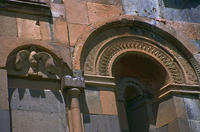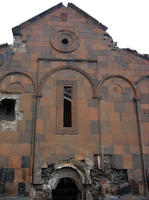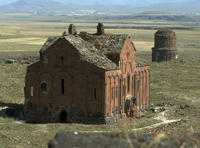You are in: Asia -> Turkey -> Archaeological Site ... , and traditional search or Image Gallery will yield results of this site only
Archaeological Site of Ani
| Site number: | 1518 |
|
| Type of site: | Cultural | |
| Date: | 10-13 century | |
| Date of Inscription: | 2016 | |
| Location: | Eurasia, Turkey, Ani | |
Up to 75 images are shown here. Click on each for more details or on Image Gallery for more images.
| Description: | This site is located on a secluded plateau of northeast Turkey overlooking a ravine that forms a natural border with Armenia. This medieval city combines residential, religious and military structures, characteristic of a medieval urbanism built up over the centuries by Christian and then Muslim dynasties. The city flourished in the 10th and 11th centuries CE when it became the capital of the medieval Armenian kingdom of the Bagratides and profited from control of one branch of the Silk Road. Later, under Byzantine, Seljuk and Georgian sovereignty, it maintained its status as an important crossroads for merchant caravans. The Mongol invasion and a devastating earthquake in 1319 marked the beginning of the city’s decline. The site presents a comprehensive overview of the evolution of medieval architecture through examples of almost all the different architectural innovations of the region between the 7th and 13th centuries CE. --WHMNet's description is from WHC Site, where additional information is available. | |
| Ani Cathedral (Turkish: Ani Katedrali) is a partially ruined Armenian church in the abandoned medieval city of Ani, located in present-day eastern Turkey, on the border with modern Armenia. It was completed in the early 11th century (1001 or 1010) by the architect Trdat and served, until the mid-11th century, as the seat of the catholicos, the head of the Armenian Apostolic Church. In 1064, following the Seljuk conquest of Ani, the cathedral was converted into a mosque. It later returned to being used as an Armenian church. It eventually suffered damage in a 1319 earthquake when its conical dome collapsed. Subsequently, Ani was gradually abandoned. The north-western corner of the church was heavily damaged by a 1988 earthquake. --Wikipedia. Text is available under the Creative Commons Attribution-ShareAlike License. | ||
| Source: | http://whc.unesco.org/en/list/1518 | |
| Source2: | Wikipedia (http://wikipedia.com) | |
| Reference: | 1. UNESCO World Heritage Center (http://whc.unesco.org/en/list/1518). 2. Wikipedia. | |










